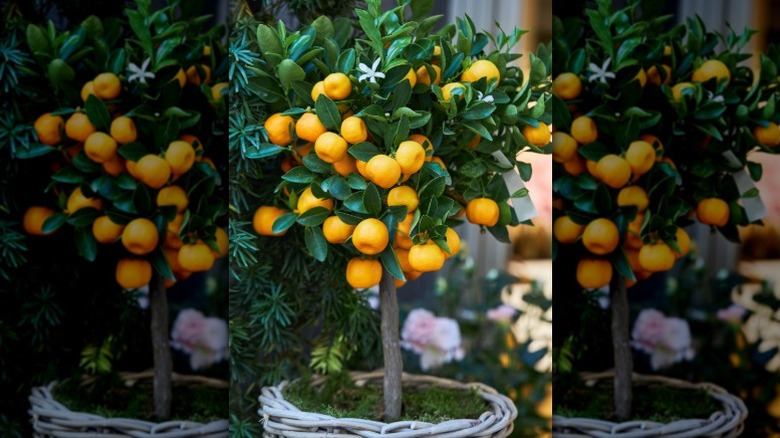The Orange Tree Variety That's Great For Growing In Containers And Small Spaces
If you only have a small space to grow delicious fruits and other edible plants, you're probably familiar with growing in containers. You may also know that there definitely is such a thing as container gardening for trees, and you might even already have a few dwarf fruit trees you're nurturing. Many citrus trees are vigorous growers, and most orange varieties are too large for growing in pots. However, one variety that you might not have come across that is great for growing in containers and other small spaces is the calamondin, which is believed to be a natural hybrid of the kumquat. And just like the kumquat, you don't need a big yard to grow this unique citrus tree.
The calamondin orange variety (Citrofortunella microcarpa) is not only a lovely, compact ornamental tree, but it also has the cutest little brightly colored fruits, measuring around 1 to 2 inches in diameter. These fruits are packed with juicy, tart goodness and have a sweet, tender skin that's also edible. Once a calamondin starts bearing fruit, you'll be able to enjoy a bumper harvest and delight in its fragrant white blooms.
How to grow a calamondin orange variety in your small space
If you live anywhere in USDA zones 8 through 10 (the southeastern and southwestern U.S.), you can easily grow these trees outdoors in a container. Although young trees need winter protection during their first two to three years, more mature ones are fairly cold-hardy down to 20 degrees Fahrenheit. Ideally, you want to grow this tree in a large container and use quality potting soil. Position your potted calamondin in a sunny spot, although it can handle a little afternoon shade and still fruit reasonably well.
Ensure your chosen container has adequate drainage holes because citrus trees don't like having wet feet. On the other hand, your tree will need more regular watering than those grown in the ground. It's always a good idea to check if the top 1 to 2 inches of soil are dry and only then give it a good drink. Your calamondin tree will also require regular fertilizing, first around February and then twice more during spring and summer. Using a slow-release citrus feed is ideal. You'll generally find that pruning won't be necessary — except to keep your tree to a manageable size. Finally, if you happen to live just outside the recommended outdoor planting zones, you can still grow a calamondin tree in a suitable container and bring it inside for the winter — as long as you're aware of things such as self-pollinating that you should know about before growing a citrus tree indoors.

